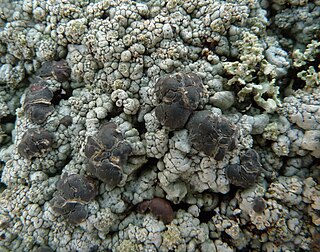
Trapeliopsis is a genus of lichenized fungi in the family Trapeliaceae. It contains 20 species. The genus was circumscribed in 1980 by Hannes Hertel and Gotthard Schneider, with Trapeliopsis wallrothii designated as the type species.

Fissurina is a genus of lichenized fungi in the family Graphidaceae. It has about 160 species, most of which are found in tropical regions.

Diorygma is a genus of lichen-forming fungi in the family Graphidaceae. The genus was circumscribed by Franz Gerhard Eschweiler in 1824. Species of the genus are widely distributed in tropical and subtropical regions of the world.

Acanthothecis is a genus of lichen-forming fungi in the family Graphidaceae. The genus was circumscribed by Frederick Edward Clements in 1909.

Gassicurtia is a genus of lichenized fungi in the family Caliciaceae.

Cresponea is a genus of lichens in the family Roccellaceae. The genus, circumscribed in 1993, contains species that were formerly classified in Lecanactis. Cresponea is widely distributed, but most species are found in tropical and subtropical regions. The genus is named in honor of Spanish lichenologist Ana Crespo.

Chiodecton is a genus of lichens in the family Roccellaceae. The genus was circumscribed by lichenologist Erik Acharius in 1814, with Chiodecton sphaerale assigned as the type species.

Enterographa is a genus of lichens in the family Roccellaceae.

Syncesia is a genus of lichen-forming fungi in the family Roccellaceae.

Absconditella is a genus of lichenised fungi in the family Stictidaceae. The genus was circumscribed in 1965 by Czech lichenologist Antonín Vězda, with Absconditella sphagnorum assigned as the type species. Absconditella is characterised by gyalectoid apothecia with a hymenium that is not amyloid, without a dark pigment and thalli containing green algae as photobionts. The genus name means "hidden", a reference to the scant structure of the thallus and its small apothecia.
Synarthonia is a genus of lichen-forming fungi in the order Arthoniales. The genus has not been placed into a family. Synarthonia was circumscribed by Swiss lichenologist Johannes Müller Argoviensis in 1891.

Chrysothrix is a genus of lichen-forming fungi in the family Chrysothricaceae. They are commonly called gold dust lichens or sulfur dust lichens, because they are bright yellow to greenish-yellow, sometimes flecked with orange, and composed entirely of powdery soredia. Apothecia are never present in North American specimens.

Herpothallon is a genus of crustose lichens in the family Arthoniaceae. It has about 50 species.
Pertusaria lichexanthofarinosa is a rare species of crustose and corticolous (bark-dwelling) lichen in the family Pertusariaceae. Found in Bahia, Brazil, it was formally described as a new species in 2018 by lichenologists André Aptroot and Marcela Eugenia da Silva Cáceres. The type specimen was collected by the authors near the Cachoeira do Mosquito at an altitude between 450 and 500 m ; here the lichen was found growing on tree bark in Atlantic Forest. Pertusaria lichexanthofarinosa is only known to occur at the type locality, and is only known from the type specimen. The specific epithet lichexanthofarinosa refers both to the presence of the cortical secondary chemical lichexanthone, as well as the farinose soredia.
Pertusaria lichexanthoimmersa is a rare species of crustose and corticolous (bark-dwelling) lichen in the family Pertusariaceae. Found in Bahia, Brazil, it was formally described as a new species in 2018 by lichenologists André Aptroot and Marcela Eugenia da Silva Cáceres. The type specimen was collected by the authors from the Morro do Pai Inácio at an altitude between 1,050 and 1,140 m ; here the lichen was found growing on tree bark in a transitional forest. Pertusaria lichexanthoimmersa is only known to occur at the type locality, and is only known from the type specimen. The specific epithet lichexanthoimmersa refers both to the presence of lichexanthone as a secondary chemical, and the apothecia, which are immersed in the thallus. The lichen also contains norstictic acid.
Pertusaria lichexanthoverrucosa is a rare species of crustose and corticolous (bark-dwelling) lichen in the family Pertusariaceae. Found in Bahia, Brazil, it was formally described as a new species in 2018 by lichenologists André Aptroot and Marcela Eugenia da Silva Cáceres. The type specimen was collected by the authors near the Cachoeira do Mosquito at an altitude between 450 and 500 m ; here the lichen was found growing on tree bark in Atlantic Forest near a river. Pertusaria lichexanthoverrucosa is only known to occur at the type locality, which is part of the Chapada Diamantina mountains. The specific epithet lichexanthoverrucosa refers to both the presence of lichexanthone as well as the verrucose (warty) thallus.
Myriostigma is a genus of lichens in the family Arthoniaceae. The genus was circumscribed by German lichenologist August von Krempelhuber in 1874.

Heiomasia is a genus of corticolous (bark-dwelling), crustose lichens in the family Graphidaceae. It has five species.

Coniocarpon is a genus of lichen-forming fungi in the family Arthoniaceae. It has eight species of corticolous (bark-dwelling) lichens. This genus is distinct for its crystalline orange, red, and purple quinoid pigments in the ascomata that turn purple in potassium hydroxide solution, its colourless, transversely septate ascospores with large apical cells, and its rounded to lirellate ascomata.















